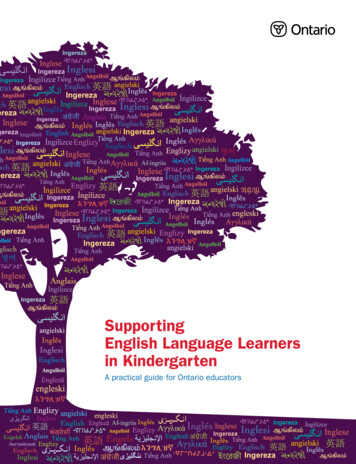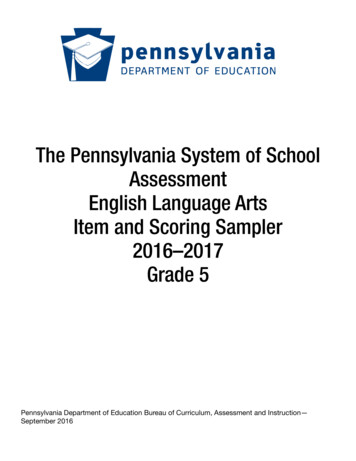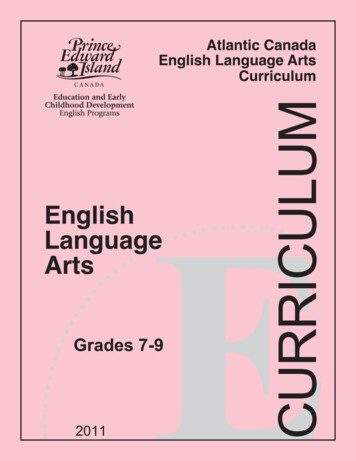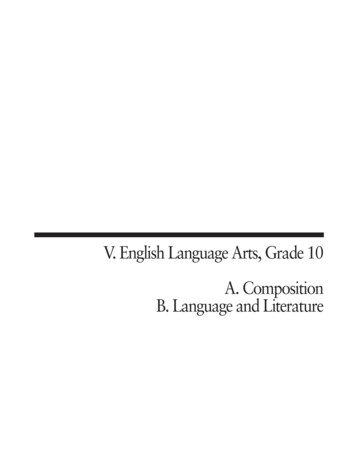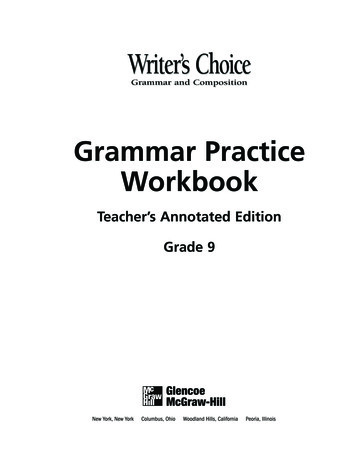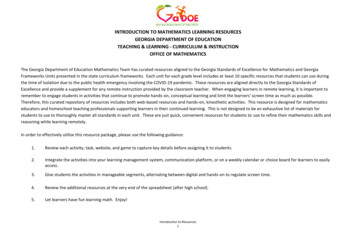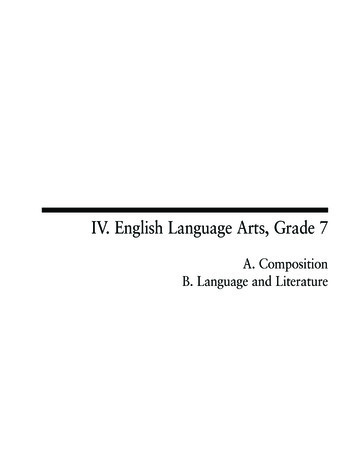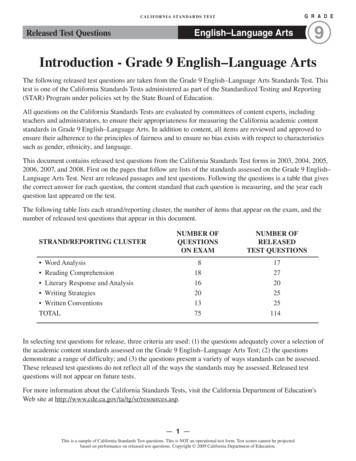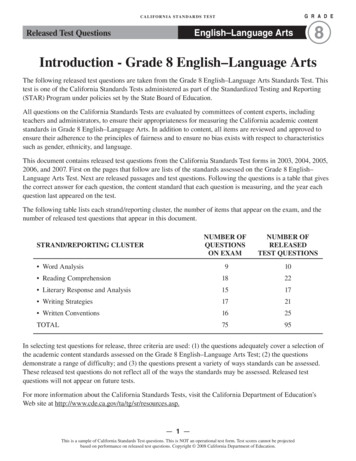
Transcription
G R A D ECA L I F O R N I A S TA N DA R D S T E S TEnglish–Language ArtsReleased Test Questions8Introduction - Grade 8 English–Language ArtsThe following released test questions are taken from the Grade 8 English–Language Arts Standards Test. Thistest is one of the California Standards Tests administered as part of the Standardized Testing and Reporting(STAR) Program under policies set by the State Board of Education.All questions on the California Standards Tests are evaluated by committees of content experts, includingteachers and administrators, to ensure their appropriateness for measuring the California academic contentstandards in Grade 8 English–Language Arts. In addition to content, all items are reviewed and approved toensure their adherence to the principles of fairness and to ensure no bias exists with respect to characteristicssuch as gender, ethnicity, and language.This document contains released test questions from the California Standards Test forms in 2003, 2004, 2005,2006, and 2007. First on the pages that follow are lists of the standards assessed on the Grade 8 English–Language Arts Test. Next are released passages and test questions. Following the questions is a table that givesthe correct answer for each question, the content standard that each question is measuring, and the year eachquestion last appeared on the test.The following table lists each strand/reporting cluster, the number of items that appear on the exam, and thenumber of released test questions that appear in this document.NUMBER OFQUESTIONSON EXAMNUMBER OFRELEASEDTEST QUESTIONS910 Reading Comprehension1822 Literary Response and Analysis1517 Writing Strategies1721 Written Conventions1625TOTAL7595STRAND/REPORTING CLUSTER Word AnalysisIn selecting test questions for release, three criteria are used: (1) the questions adequately cover a selection ofthe academic content standards assessed on the Grade 8 English–Language Arts Test; (2) the questionsdemonstrate a range of difficulty; and (3) the questions present a variety of ways standards can be assessed.These released test questions do not reflect all of the ways the standards may be assessed. Released testquestions will not appear on future tests.For more information about the California Standards Tests, visit the California Department of Education’sWeb site at http://www.cde.ca.gov/ta/tg/sr/resources.asp.— 1 —This is a sample of California Standards Test questions. This is NOT an operational test form. Test scores cannot be projectedbased on performance on released test questions. Copyright 2008 California Department of Education.
G R A D ECA L I F O R N I A S TA N DA R D S T E S T8English–Language ArtsReleased Test QuestionsREADINGThe Reading portion of the Grade 8 California English–Language Arts Standards Test has three strands/reporting clusters: Word Analysis, Reading Comprehension, and Literary Response and Analysis. Each ofthese strands/clusters is described below.The Word Analysis Strand/ClusterThe following three California English–Language Arts content standards are included in the Word Analysisstrand/cluster and are represented in this booklet by 10 test questions for grade 8. These questions representonly some ways in which these standards may be assessed on the Grade 8 California English–Language ArtsStandards Test.8RW1.0WORD ANALYSIS, FLUENCY, AND SYSTEMATIC VOCABULARY DEVELOPMENT:Students use their knowledge of word origins and word relationships, as well ashistorical and literary context clues, to determine the meaning of specializedvocabulary and to understand the precise meaning of grade-level appropriate words.8RW1.1Vocabulary and Concept Development: Analyze idioms, analogies, metaphors, andsimiles to infer the literal and figurative meanings of phrases.8RW1.2Vocabulary and Concept Development: Understand the most important points in thehistory of English language and use common word origins to determine the historicalinfluences on English word meanings.8RW1.3Vocabulary and Concept Development: Use word meanings within the appropriatecontext and show ability to verify those meanings by definition, restatement, example,comparison, or contrast.— 2 —This is a sample of California Standards Test questions. This is NOT an operational test form. Test scores cannot be projectedbased on performance on released test questions. Copyright 2008 California Department of Education.
CA L I F O R N I A S TA N DA R D S T E S TG R A D EEnglish–Language ArtsReleased Test QuestionsThe Reading Comprehension Strand/ClusterThe following seven California English–Language Arts content standards are included in the ReadingComprehension strand/cluster and are represented in this booklet by 22 test questions for grade 8. Thesequestions represent only some ways in which these standards may be assessed on the Grade 8 CaliforniaEnglish–Language Arts Standards Test.8RC2.0READING COMPREHENSION (FOCUS ON INFORMATIONAL MATERIALS): Studentsread and understand grade-level-appropriate material. They describe and connect theessential ideas, arguments, and perspectives of the text by using their knowledge oftext structure, organization, and purpose. The selections in Recommended Readingsin Literature, Kindergarten Through Grade Eight illustrate the quality and complexityof the materials to be read by students. In addition, students read one million wordsannually on their own, including a good representation of narrative and expositorytext (e.g., classic and contemporary literature, magazines, newspapers, onlineinformation).8RC2.1Structural Features of Informational Materials: Compare and contrast the features andelements of consumer materials to gain meaning from documents (e.g., warranties,contracts, product information, instruction manuals).8RC2.2Structural Features of Informational Materials: Analyze text that uses proposition andsupport patterns.8RC2.3Comprehension and Analysis of Grade-Level-Appropriate Text: Find similarities anddifferences between texts in the treatment, scope, or organization of ideas.8RC2.4Comprehension and Analysis of Grade-Level-Appropriate Text: Compare the originaltext to a summary to determine whether the summary accurately captures the main ideas,includes critical details, and conveys the underlying meaning.8RC2.5Comprehension and Analysis of Grade-Level-Appropriate Text: Understand andexplain the use of a complex mechanical device by following technical directions.8RC2.6Comprehension and Analysis of Grade-Level-Appropriate Text: Use information from avariety of consumer, workplace, and public documents to explain a situation or decisionand to solve a problem.8RC2.7Expository Critique: Evaluate the unity, coherence, logic, internal consistency, andstructural patterns of text.— 3 —This is a sample of California Standards Test questions. This is NOT an operational test form. Test scores cannot be projectedbased on performance on released test questions. Copyright 2008 California Department of Education.8
G R A D E8CA L I F O R N I A S TA N DA R D S T E S TEnglish–Language ArtsReleased Test QuestionsThe Literary Response and Analysis Strand/ClusterThe following seven California English–Language Arts content standards are included in the LiteraryResponse and Analysis strand/cluster and are represented in this booklet by 17 test questions for grade 8.These questions represent some ways in which these standards may be assessed on the Grade 8 CaliforniaEnglish–Language Arts Standards Test.8RL3.0LITERARY RESPONSE AND ANALYSIS: Students read and respond to historically orculturally significant works of literature that reflect and enhance their studies ofhistory and social science. They clarify the ideas and connect them to other literaryworks. The selections in Recommended Readings in Literature, KindergartenThrough Grade Eight illustrate the quality and complexity of the materials to be readby students.8RL3.1Structural Features of Literature: Determine and articulate the relationship between thepurposes and characteristics of different forms of poetry (e.g., ballad, lyric, couplet, epic,elegy, ode, sonnet).8RL3.2Narrative Analysis of Grade-Level-Appropriate Text: Evaluate the structural elements ofthe plot (e.g., subplots, parallel episodes, climax), the plot’s development, and the way inwhich conflicts are (or are not) addressed and resolved.8RL3.3Narrative Analysis of Grade-Level-Appropriate Text: Compare and contrast motivationsand reactions of literary characters from different historical eras confronting similarsituations or conflicts.8RL3.4Narrative Analysis of Grade-Level-Appropriate Text: Analyze the relevance of thesetting (e.g., place, time, customs) to the mood, tone, and meaning of the text.8RL3.5Narrative Analysis of Grade-Level-Appropriate Text: Identify and analyze recurringthemes (e.g., good versus evil) across traditional and contemporary works.8RL3.6Narrative Analysis of Grade-Level-Appropriate Text: Identify significant literary devices(e.g., metaphor, symbolism, dialect, irony) that define a writer’s style and use thoseelements to interpret the work.8RL3.7Literary Criticism: Analyze a work of literature, showing how it reflects the heritage,traditions, attitudes, and beliefs of its author. (Biographical approach)— 4 —This is a sample of California Standards Test questions. This is NOT an operational test form. Test scores cannot be projectedbased on performance on released test questions. Copyright 2008 California Department of Education.
CA L I F O R N I A S TA N DA R D S T E S TEnglish–Language ArtsReleased Test QuestionsG R A D E8WRITINGThe Writing portion of the Grade 8 California English–Language Arts Standards Test has two strands/reporting clusters: Writing Strategies and Written Conventions. Each of these strands/clusters is describedbelow.The Writing Strategies Strand/ClusterThe following four California English–Language Arts content standards are included in the Writing Strategiesstrand/cluster and are represented in this booklet by 21 test questions for grade 8. These questions representonly some ways in which these standards may be assessed on the Grade 8 California English–Language ArtsStandards Test.8WS1.0WRITING STRATEGIES: Students write clear, coherent, and focused essays. Thewriting exhibits students’ awareness of audience and purpose. Essays containformal introductions, supporting evidence, and conclusions. Students progressthrough the stages of the writing process as needed.8WS1.1Organization and Focus: Create compositions that establish a controlling impression,have a coherent thesis, and end with a clear and well-supported conclusion.8WS1.2Organization and Focus: Establish coherence within and among paragraphs througheffective transitions, parallel structures, and similar writing techniques.8WS1.3Organization and Focus: Support theses or conclusions with analogies, paraphrases,quotations, opinions from authorities, comparisons, and similar devices.8WS1.6Evaluation and Revision: Revise writing for word choice; appropriate organization;consistent point of view; and transitions between paragraphs, passages, and ideas.— 5 —This is a sample of California Standards Test questions. This is NOT an operational test form. Test scores cannot be projectedbased on performance on released test questions. Copyright 2008 California Department of Education.
G R A D E8CA L I F O R N I A S TA N DA R D S T E S TEnglish–Language ArtsReleased Test QuestionsThe Written Conventions Strand/ClusterThe following six California English–Language Arts content standards are included in the Written Conventionsstrand/cluster and are represented in this booklet by 25 test questions for grade 8. These questions representonly some ways in which these standards may be assessed on the Grade 8 California English–Language ArtsStandards Test.8WC1.0WRITTEN AND ORAL ENGLISH LANGUAGE CONVENTIONS: Students write andspeak with a command of standard English conventions appropriate to this gradelevel.8WC1.1Sentence Structure: Use correct and varied sentence types and sentence openings topresent a lively and effective personal style.8WC1.2Sentence Structure: Identify and use parallelism, including similar grammatical forms, inall written discourse to present items in a series and items juxtaposed for emphasis.8WC1.3Sentence Structure: Use subordination, coordination, apposition, and other devices toindicate clearly the relationship between ideas.8WC1.4Grammar: Edit written manuscripts to ensure that correct grammar is used.8WC1.5Punctuation and Capitalization: Use correct punctuation and capitalization.8WC1.6Spelling: Use correct spelling conventions.— 6 —This is a sample of California Standards Test questions. This is NOT an operational test form. Test scores cannot be projectedbased on performance on released test questions. Copyright 2008 California Department of Education.
CA L I F O R N I A S TA N DA R D S T E S TEnglish–Language ArtsReleased Test QuestionsG R A D E8Read the following two selections. Think about how they are alike and how they are different.Reminiscingby Ralph Cortez1234567891011121314Watermelons were so much sweeter then,When boys were the stuff of super men,And summers seemed so much longer too,With nothing pending and nothing due.We were swordsmen—swashbuckling heroes,Eternal victors—never zeroes;Second basemen and clean-up hitters;Forever winners, never quitters.Play was a ritual in those days,To go on magical mind forays,To play the game with aplomb and ease,To venture forth when and where we’d please.We would feign death, and then rise up again.Watermelons were so much sweeter then.Pianoby D. H. Lawrence123456789101112Softly, in the dusk, a woman is singing to me:Taking me back down the vista of years, till I seeA child sitting under the piano, in the boom of the tingling stringsAnd pressing the small, poised feet of a mother who smiles as she sings.In spite of myself, the insidious mastery of songBetrays me back, till the heart of me weeps to belongTo the old Sunday evenings at home, winter outsideAnd hymns in the cozy parlor, the tinkling piano our guide.So now it is vain for the singer to burst into clamorWith the great black piano appassionato. The glamourOf childish days is upon me, my manhood is castDown in the flood of remembrance, I weep like a child for the past.[Public Domain]CSR1P098— 7 —This is a sample of California Standards Test questions. This is NOT an operational test form. Test scores cannot be projectedbased on performance on released test questions. Copyright 2008 California Department of Education.
G R A D E81 CA L I F O R N I A S TA N DA R D S T E S TEnglish–Language ArtsReleased Test QuestionsThe word “appassionato” in line 10 of “Piano”contains a Latin root that tells you that themusic is playedAsoftly and quietly.Bloudly and humorously.Cwith a gentle touch.Dwith strong feeling. In “Piano,” what causes the speaker to recalla memory?Aa winter dayBa woman singingCthe sight of a pianoDfamiliar musicCSR10208.0985 CSR01333.19824 What is the main purpose of “Reminiscing”?The structure of “Reminiscing” is similar tothat of “Piano” in that both poemsAto tell a story about a childhood experienceAseparate ideas into stanzas.Bto capture a feeling from the pastBalternate the length of lines.Cto debate whether childhood or adulthood isbetterCorganize lines into rhyming couplets.Duse the same number of syllables per line.Dto describe a person who was important in thelife of a childCSR10200.0983 In lines 11 and 12 of “Piano,” the words “mymanhood is cast down in the flood ofremembrance” mean that the speaker feelsAproud of what he has accomplished.Bstrongly connected to his father.Cthat his mother relied on him when he wasa child.Das if he were a child.CSR01334.198— 8 —This is a sample of California Standards Test questions. This is NOT an operational test form. Test scores cannot be projectedbased on performance on released test questions. Copyright 2008 California Department of Education.CSR10199.098
CA L I F O R N I A S TA N DA R D S T E S TG R A D E8English–Language ArtsReleased Test QuestionsDocument AEvergreen Teen Book Club OfferThe Evergreen Teen Book Club invites you to join us and take full advantage of our limited-time introductory offer.If you join our club, you will receive a certificate for 3 free books. These are yoursto keep, even if you decide to cancel your membership. However, if you decide topurchase just one book at regular club price, you will receive a certificate for anadditional 3 free selections after your first order is placed.As our member, you can benefit from all of our super sales and our BonusProgram. You accumulate 2 bonus points with each cash purchase of one book.Every 6 bonus points will earn you a certificate for one free book!To join our club, fill in the brief application listing your name, address, and phone number on the postage-paid cardat the bottom of this page. Then drop the card in the mail and our current catalog will be immediately mailed out toyou for your 3 free selections!This catalog offers a wide selection of over 500 books in every issue, including mysteries, romances, adventures,biographies, cookbooks, crafts, sports, and many more. Our catalog also contains such highlights as interviews withyour favorite authors, reviews of newly released novels, and a teen top-ten list for both fiction and nonfiction.Once you are a member, you will receive our catalog bimonthly, but you are under no obligation to purchase anyselections. We send you only exactly what you order.If you join before June 30th, we will also provide complimentary shipping and handling on your first selections,even if you choose to order nothing except your 3 free books.You can build a great book collection!Begin now by taking advantage of this phenomenal offer.Document BEvergreen Teen Book Club Return PolicyWhen receiving your order, please check all items. If you are not completely satisfied with your purchase,you may return it to us within 21 days of receipt. This can be done by attaching the pre-addressed returnlabel enclosed in every shipment.Upon receiving a returned book or order, your refund will be processed, but you will not be reimbursed forshipping charges. You will receive a full refund for all returned items on the condition that they areunworn, undamaged, and returned within 21 days. You can choose to have a check mailed to yourshipping address or to have the amount credited to your account. Your preference can be noted bychecking the appropriate box on the return label.Any return due to shipping error or product defect may be returned free of charge. Simply notify us of theproblem, and we will be happy to include the shipping amount in your refund.In this instance, contact our Customer Service Department by calling 1-800-613-XXXX between 9:00 a.m.and 5:00 p.m. (EST). Our customer representatives will be happy to assist you.Thank you for your business. Evergreen Teen values its customers, and your satisfaction is our goal!CSR0P278— 9 —This is a sample of California Standards Test questions. This is NOT an operational test form. Test scores cannot be projectedbased on performance on released test questions. Copyright 2008 California Department of Education.
G R A D E86 CA L I F O R N I A S TA N DA R D S T E S TEnglish–Language ArtsReleased Test Questions9 Read this sentence from Document A.AYou checked a box on the mailing label.BYou listed it ahead of time on yourapplication.A phenomenal offer is one that isCYou called the Customer Service Department.Anot true.DYou indicated it on the certificate you used.Bstandard.Ctemporary.Dextraordinary.Begin now by taking advantage of thisphenomenal offer.7 How does the club know what to do about yourrefund?CSR02039.27810 Shipping charges for returns will be paid by theclub whenAyou return a book within 21 days.Document A tries to do all of these exceptByou request credit rather than a check.Ainterest you in reading.Cthe wrong order was shipped.Bconvince you to buy something.Da book is not as interesting as advertised.Coffer you extra benefits.Dexplain a warranty to you.CSR02036.278CSR02034.278CSR02043.2788 The purpose of Document B is to explainAwhy damaged items cannot be returned.Bwhy shipping charges for returns will notbe paid.Chow a return should be processed.Dhow customer representatives will help you.CSR02047.278— 10 —This is a sample of California Standards Test questions. This is NOT an operational test form. Test scores cannot be projectedbased on performance on released test questions. Copyright 2008 California Department of Education.
CA L I F O R N I A S TA N DA R D S T E S TEnglish–Language ArtsReleased Test QuestionsG R A D E8Document ASun Veil Sunscreen 30Don’t Go Out Without It. Every day you run the risk of skin damage caused by the sun. Harmfulultraviolet rays are dangerous even on cold, cloudy days. Sunscreen isimportant year-round no matter where you live. Sun Veil is the ultimate in sun and skin care products. Sun Veil Sunscreenreduces the harmful effects of the sun. Remember, you are being struck by thesun’s powerful rays when you are . . . DRIVING A CAR WALKING TO THE STORE PLAYING ON THE PLAYGROUND RELAXING AT THE BEACH OR POOL PARTICIPATING IN OUTDOORSPORTS OR RECREATIONSun Veil Sunscreen protects you so you can have fun in the sun, young or old.Sun Veil Sunscreen is guaranteed 100% effective or your money back.— 11 —This is a sample of California Standards Test questions. This is NOT an operational test form. Test scores cannot be projectedbased on performance on released test questions. Copyright 2008 California Department of Education.
G R A D E8CA L I F O R N I A S TA N DA R D S T E S TEnglish–Language ArtsReleased Test QuestionsDocument BSunscreen30Sun Veil Sunscreen provides long-lasting waterproof protection from the sun’s burning UVA andUVB rays that will last for a full six hours in or out of water. Sun Veil’s nonirritating and mildformula is ideal for youngsters.DIRECTIONS:Apply Sun Veil’s disappearing blue-colored sunblock liberally to completely cover all exposedskin. The blue color disappears as you rub Sun Veil Sunscreen into the skin. The coloring is safeand easily washes from most clothing. For best results, allow Sun Veil Sunscreen to dry for15 minutes before exposure to the sun.NOTE: Prolonged swimming, excess sweating, or frequent towel drying may reduce theeffectiveness of sunscreen. Reapplication is recommended when these circumstances exist.WARNING:Avoid contact with eyes.If the skin becomes irritated or a rash develops, discontinue use immediately.In case of accidental swallowing, contact the poison control center immediately.Sun Veil Sunscreen is NOT recommended for infants under the age of 6 months.SUN ALERT:According to the National Council of Dermatologists, limiting sun exposure, wearing protectiveclothing, and using sunscreens may reduce the risk of skin damage and other harmful effects ofthe sun.Questions or Comments?Call 1-311-555-0132Monday–Friday9 AM–5 PMSouth Shore Cosmetics, Inc.CSR1P096— 12 —This is a sample of California Standards Test questions. This is NOT an operational test form. Test scores cannot be projectedbased on performance on released test questions. Copyright 2008 California Department of Education.
CA L I F O R N I A S TA N DA R D S T E S TThe purpose of including the list of activities inDocument A is to illustrate to the consumerthat Sun Veil Sunscreen 30 isAfor both adults and children.Bnecessary almost all of the time.Cavailable almost everywhere.Dbetter than others on the market. 14 What information appears in Document A thatdoes not appear in Document B?Adirections for using the productBthe extent of the product guaranteeChow long the product lasts once appliedDwhat to do if the product causes a rashCSR10496.096CSR10168.09612The smiling face that serves as the Sun Veil logoimplies that the product makes being in the sun15 While the advertisement (Document A) iswritten to persuade the consumer, the purposeof the product label (Document B) isAfun.Ato influence.Beasy.Bto encourage.Cpractical.Cto inform.Dadventurous.Dto entertain.CSR10171.09613 8English–Language ArtsReleased Test Questions11 G R A D ECSR00543.05716 Read this sentence from Document B.Sun Veil Sunscreen provides long-lastingwaterproof protection from the sun’sburning UVA and UVB rays that will lastfor a full six hours in or out of water.Both documents tell the consumerAhow to use the Sun Veil product.Bhow to contact the manufacturer.Cwhere to purchase the product.Dabout the dangers of sun exposure.CSR10174.096In which sentence does the word burning havethe same meaning as in the sentence above?AThe burning candle gave off a wonderfulscent.BWhat to have for lunch that day was theburning issue.CLin had a burning need to know the outcomeof the game.DAngeline ran barefoot across the burningpavement.CSR10176.096— 13 —This is a sample of California Standards Test questions. This is NOT an operational test form. Test scores cannot be projectedbased on performance on released test questions. Copyright 2008 California Department of Education.
G R A D E8CA L I F O R N I A S TA N DA R D S T E S TEnglish–Language ArtsReleased Test QuestionsMurphyfrom “Dogs That Have Known Me”How I Got to Be Perfectby Jean Kerr1The dog that gave us the most trouble was a beagle named Murphy. As faras I’m concerned, the first thing he did wrong was to turn into a beagle. I hadseen him bounding around on the other side of a pet-shop window, and I wentin and asked the man, “How much is that adorable fox terrier in the window?”Did he say, “That adorable fox terrier is a beagle”? No, he said, “Ten dollars,lady.” Now, I don’t mean to say one word against beagles. They have rightsjust like other people. But it is a bit of a shock when you bring home a smallball of fluff in a shoebox, and three weeks later it’s as long as the sofa.2Murphy was the first dog I ever trained personally, and I was delighted at the enthusiasm with which hetook to the newspaper. It was sometime later that we discovered, to our horror, that—like so many dogs—hehad grasped the letter but not the spirit of the thing. Until the very end of his days he felt a real sense ofobligation whenever he saw a newspaper—any newspaper—and it didn’t matter where it was. I can’t bringmyself to go into the details, except to mention that we were finally compelled to keep all the papers in thebottom of the icebox.3He had another habit that used to leave us open to a certain amount of criticism from our friends who werenot dogophiles. He never climbed up on beds or chairs or sofas. But he always sat on top of the piano. In thebeginning we used to try to pull him off of there. But after a few noisy scuffles in which he knocked a pictureoff the wall, scratched the piano, and smashed a lamp, we just gave in—only to discover that, left to his owndevices, he hopped up and down as delicately as a ballet dancer.4It’s not just our own dogs that bother me. The dogs I meet at parties are even worse. I don’t know whatI’ve got that attracts them; it just doesn’t bear thought. My husband swears I rub chopped meat on my ankles.But at every party it’s the same thing. I am sitting with a group in front of the fire when all of a sudden thelarge mutt of the host appears in the archway. Then, without a single bark of warning, he hurls himself uponme. He settles down peacefully on my lap. I blow out such quantities of hair as I haven’t swallowed andglance at my host, expecting to be rescued. He murmurs, “Isn’t that wonderful? You know, Brucie is usuallyso distant with strangers.”5At a dinner party last week, after I had been mugged by a large sheepdog, I announced quite piteously,“Oh dear, he seems to have swallowed one of my earrings.” The hostess looked really distressed for amoment, until she examined the remaining earring. Then she said, “Oh, I think it will be all right. It’s smalland round.”6Nowadays if I go anywhere I just ask if they have a dog. If they do, I say, “Maybe I’d better keep awayfrom him—I have this bad allergy.” This does not really charm the lady of the house. In fact, she behavesrather as though she’d just discovered that I was back in analysis for my kleptomania. But it is safer. Itreally is.Copyright 1957 Condé Nast Publications Inc. All rights reserved. Originally published in Vogue. Reprinted by permission.— 14 —This is a sample of California Standards Test questions. This is NOT an operational test form. Test scores cannot be projectedbased on performance on released test questions. Copyright 2008 California Department of Education.CSR1P263
CA L I F O R N I A S TA N DA R D S T E S T8English–Language ArtsReleased Test Questions17 G R A D E19 Read this sentence from paragraph 1 ofthe essay.But it is a bit of a shock when you bringhome a small ball of fluff in a shoebox,and three weeks later it’s as long as thesofa.In paragraph 6, why does the author avoidcontact with dogs?AExposure to dogs causes her to sneeze.BDogs cause mishaps to occur.CHosts insist on saving her from their dogs.DShe dislikes most types of dogs.CSR12581.263The author uses a hyperbole to illustrate thatthe dog grewAsurprisingly affectionate.Bcomfortable in the house.Ctoo large to fit on a couch.Dlarger than expected.CSR12123.26318 Which excerpt reveals the author’s inability totrain Murphy?AI had seen him bounding around on the otherside of a pet-shop window . . .B. . . we were finally compelled to keep all thepapers in the bottom of the icebox.CHe never climbed up on beds or chairs . . .D. . . all of a sudden the large mutt of the hostappears . . .CSR12128.263— 15 —This is a sample of California Standards Test questions. This is NOT an operational test form. Test scores cannot be projectedbased on performance on released test questions. Copyright 2008 California Department of Education.
G R A D E8CA L I F O R N I A S TA N DA R D
The Reading Comprehension Strand/Cluster The following seven California English–Language Arts content standards are included in the Reading Comprehension strand/cluster and are represented in this booklet by 22 test questions for grade 8. These questions represent only some ways in which these standards m
